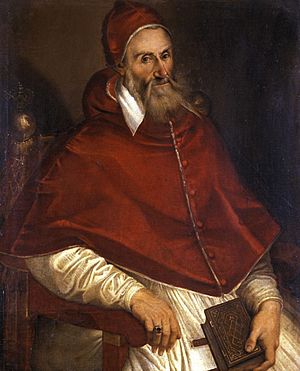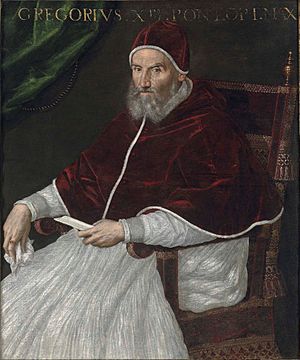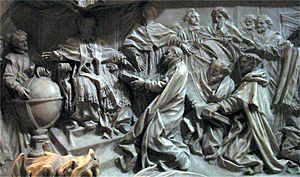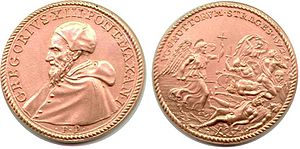Pope Gregory XIII facts for kids
Quick facts for kids Pope Gregory XIII |
|
|---|---|
| Bishop of Rome | |

|
|
| Church | Catholic Church |
| Papacy began | 13 May 1572 |
| Papacy ended | 10 April 1585 |
| Predecessor | Pius V |
| Successor | Sixtus V |
| Orders | |
| Ordination | 31 July 1558 |
| Consecration | 6 August 1558 by Girolamo Maccabei |
| Created Cardinal | 12 March 1565 |
| Personal details | |
| Birth name | Ugo Boncompagni |
| Born | 7 January 1502 Bologna, Papal States |
| Died | 10 April 1585 (aged 83) Rome, Papal States |
| Previous post |
|
| Alma mater | University of Bologna |
| Motto | Aperuit et clausit ("Opened and closed") |
| Coat of arms |  |
| Other Popes named Gregory | |
Pope Gregory XIII (born Ugo Boncompagni; 7 January 1502 – 10 April 1585) was the leader of the Catholic Church and ruler of the Papal States. He served from May 13, 1572, until his death in April 1585. He is most famous for creating and naming the Gregorian calendar. This calendar is still used around the world today as the main civil calendar.
Contents
Early Life and Career
Youth and Education
Ugo Boncompagni was born in Bologna. His parents were Cristoforo Boncompagni and Angela Marescalchi. He studied law at the University of Bologna and graduated in 1530. After finishing his studies, he taught law for several years. Some of his students became very important figures, like Cardinals Alexander Farnese and Charles Borromeo. Before he became a priest, Ugo Boncompagni had a son named Giacomo Boncompagni.
Path to Becoming Pope
When he was 36, Pope Paul III called him to Rome. There, he held several important jobs, including a judge and a vice-chancellor. Later, Pope Paul IV gave him more duties. Pope Pius IV made him a Cardinal-Priest and sent him to the Council of Trent.
Ugo Boncompagni also worked as a special representative, called a legate, for Philip II of Spain. He was sent to investigate a cardinal in Toledo. During this time, he built a strong relationship with the Spanish King. This connection later helped him with his plans as Pope.
Becoming Pope Gregory XIII
After Pope Pius V died, a meeting of cardinals, called a conclave, chose Cardinal Boncompagni as the new Pope. He chose the name Gregory XIII. He did this to honor Gregory the Great, an important reforming pope from the 6th century.
The conclave was very quick, lasting less than 24 hours. Many historians believe this was because the Spanish king supported him. Cardinal Borromeo and other cardinals who wanted reforms also agreed he was a good choice. Gregory XIII was known for his intelligence and good management skills. These qualities helped him deal with big problems quickly.
Key Actions as Pope
Reforming the Church

Once he became Pope, Gregory XIII focused on improving the Catholic Church. He put into action the ideas from the Council of Trent. He made it a rule that cardinals had to live in their own church areas. He also created a group to update the Index of Forbidden Books. This was a list of books that Catholics were not allowed to read.
Pope Gregory XIII also supported a new and better version of church law books. He changed how the cardinals worked, giving them specific tasks. He was known for making his own decisions and not always asking for advice. Under his leadership, the Pope's power grew, while the cardinals' power became less.
He also officially recognized the Discalced Carmelites. This was a new group of the Carmelite Order. This helped them become an important religious order in the Catholic Church.
Supporting Education and Arts
Gregory XIII was a big supporter of the Jesuit colleges in Rome. The Roman College of the Jesuits became very important under his care. For a while, it was the top learning center in Europe. Today, it is called the Pontifical Gregorian University.
Pope Gregory XIII also started many seminaries to train priests. He began with the German College in Rome and put the Jesuits in charge of these schools. In 1575, he officially recognized the Congregation of the Oratory. This was a group of priests who focused on prayer and preaching.
In 1580, he hired artists like Ignazio Danti to decorate the Vatican. He also asked for the creation of The Gallery of Maps. Gregory also changed a Dominican school in Rome into the College of St. Thomas in 1580. This college later became the Pontifical University of St. Thomas Aquinas.
The Gregorian Calendar
Pope Gregory XIII is most famous for creating the Gregorian calendar. The idea for this calendar came from doctor and astronomer Aloysius Lilius. Jesuit priest and astronomer Christopher Clavius helped make the final changes. This new calendar was much more accurate than the old Julian calendar. The Julian calendar treated every year as exactly 365 days and 6 hours long. However, a real year is a little shorter.
Because of this small difference, the date of the spring equinox (when day and night are equal) had slowly moved. Over 13 centuries, it had shifted from March 21 to March 10. This made it harder to calculate the correct date for Easter. Clavius confirmed this problem.
So, Pope Gregory XIII announced a new rule on February 24, 1582. He said that the day after Thursday, October 4, 1582, would be October 15, not October 5. This skipped 10 days to fix the calendar. Because of his role, the new calendar was named the Gregorian calendar. It is now used almost everywhere in the world.
Many people did not like this change at first. They worried that landlords would cheat them out of rent. But Catholic countries like Spain, Portugal, and Italy quickly adopted it. France and parts of Germany and Switzerland followed within a few years. Austria and Hungary adopted it in 1587.
It took more than a century for Protestant countries to accept the new calendar. Great Britain and its American colonies adopted it in 1752. Sweden followed in 1753. Eastern Christian countries did not accept it for hundreds of years, and then only as a civil calendar.
Foreign Relations

Pope Gregory XIII was worried about the Turks invading Europe. But he focused more on the dangers from Protestants. He supported Philip II of Spain's plans to remove Elizabeth I of England from her throne. This made English Protestants suspicious of Catholics, seeing them as possible traitors.
In 1578, Gregory helped English and Irish Catholics who were in exile. He gave an adventurer named Thomas Stukeley a ship and 800 men. They were meant to go to Ireland to help Catholics against Protestant settlements. But Stukeley joined another king instead.
Another papal group sailed to Ireland in 1579 with only 50 soldiers. They took part in the Second Desmond Rebellion. Sadly, all the soldiers and sailors were killed when they landed in Kerry.
In 1580, English Jesuits convinced him to ease a rule that had removed Queen Elizabeth I from the Church. Catholics were told to obey the queen in everyday matters. This was until a good chance came to overthrow her.
After the St. Bartholomew's Day Massacre in France in 1572, Pope Gregory showed his approval. He celebrated a special mass for it. He also had three paintings made in the Vatican showing these events. A special medal was made with Gregory's picture on it. On the other side, it showed an angel with a sword and the words "Overthrow of the Huguenots."
Pope Gregory XIII also met with the Tenshō embassy from Japan. He was the first Pope to ever receive such a visit from Japan.
Building and Patronage
In Rome, Gregory XIII built the Gregorian chapel in St. Peter's Basilica. He also made the Quirinal Palace bigger in 1580. In 1575, he turned the old Baths of Diocletian into a place to store grain.
He made his son, Giacomo Boncompagni, the commander of Sant'Angelo. Giacomo also became a military leader for the Church. Venice and Philip II of Spain also honored his son. Gregory helped his son become a powerful landowner by buying him the Duchy of Sora.
To get money for his projects, Gregory took control of many houses and properties in the Church's lands. This helped his treasury for a while. But it also made many nobles and wealthy people upset. This caused problems and unrest in the Papal States.
New Saints and Cardinals
During his time as Pope, Gregory XIII made four new saints. In 1584, he honored his predecessor, Pope Gregory VII.
He also appointed 34 new cardinals in eight meetings. This included his nephew, Filippo Boncompagni, in 1572. Gregory XIII also named four future Popes as cardinals in 1583: Giovanni Battista Castagna (Urban VII), Niccolò Sfondrati (Gregory XIV), Giovanni Antonio Facchinetti (Innocent IX), and Alessandro de' Medici (Leo XI).
Death
Pope Gregory XIII became ill with a fever on April 5, 1585. On April 7, he still said his private Mass, even though he was not feeling well. He seemed to get better and held meetings on April 8 and 9. But on April 10, his health suddenly worsened. He was confined to his bed and had cold sweats and a weak pulse. He received his last rites just moments before he passed away.
See also
 In Spanish: Gregorio XIII para niños
In Spanish: Gregorio XIII para niños



